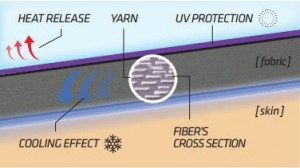While the future of wearable tech and smart fabrics is undoubtedly exciting, style and comfort will be key for the discerning consumer.
Sponsored by Nilit
There was a time when a hulking, boxy off-white computer that weighed 50 pounds was considered advanced technology. And who can forget Gordon Gekko, played by Michael Douglas in the 1987 film Wall Street, talking into a cell phone the size of a cinder block?
Today, every new laptop has to be lighter than the last, every new tablet sleeker. Even smartphones, with their ultra-thin designs and endless array of cases and covers, are fashion accessories, practically an extension of a person’s outfit. It’s no longer simply about having tech. It’s about having the best tech, the most stylish design, and the most seamless integration into users’ lives. Consumers aren’t willing to compromise, and companies like Apple have built empires catering to those high expectations.
There is very little doubt that wearable tech is the next frontier in apparel, and when it comes to things like athletic garments that measure heart rate and denim jackets that can control a smartphone, that three-pronged focus on technology, design and usability is going to be more important than ever. That means that fabric makers will need to develop an innovative approach to e-textiles, or the fabrics used in conjunction with the electronics in these garments, combining fashion and function.
So what will it take to be successful in e-textiles?

Big things on the horizon
If there’s any doubt about how major the wearable tech market is going to become, consider the collaboration between Google and Levi’s. In Project Jacquard, the two Bay area companies are pairing up to produce fabrics that can conduct electricity, with the ultimate goal of enabling touch and gesture interactivity. In other words, being able to make a call with your smartphone by touching your pants, or turning on your speakers with the flick of a wrist.
If you’re thinking it’s going to be a while before you’re firing up the coffeemaker by dancing into the kitchen, you might be right. But the e-textile revolution in athletic performance garments is already underway.
From Gold Rush era to E-Textiles – The history of Nylon >>
High-tech Sweat
Performance garments that collect biometric data and transmit it to a computing device available to a coach or trainer are a natural successor to the integral but cumbersome heart rate monitors already being worn by many professional teams.
The German men’s national soccer team captured the 2014 FIFA World Cup wearing smart jerseys designed by Adidas. These jerseys are the result of a collaboration between the Adidas miCoach system and integrated performance training company EXOS. By tracking players’ performance metrics — distance, speed, acceleration, power and heart rate — Germany’s coaches were able plan future practices and workouts in order to make improvements in necessary categories, and to use players strategically during games according to their individual skills.
In the United States, several NBA teams have begun testing OptimEye, a device made by Australian company Catapult Sports. OptimEye is embedded into a jersey between the shoulder blades and collects data on a player’s velocity, distance, acceleration, deceleration, jump height, heart rate and more.
With the way the average exerciser or casual athlete has been able to adopt the sweat-wicking, body-cooling, anti-bacterial performance garments worn by the pros, it was only a matter of time before performance garments complete with technology like heart rate monitors and satellite tracking became available for amateur athletes as well. Ralph Lauren sells its PoloTech compression workout shirt (developed with Canadian company OnSignal), a fashionable garment that tracks the wearer’s heart rate, breathing depth, stress levels, balance, calories burned, and other metrics.
Montreal-based Hexoskin has developed a smart shirt for runners and other athletes that, when connect to an app-driven device, measures heart rate, breathing, steps, pace and calories. The women’s version has a built-in shelf bra for added support and comfort. A version of the shirt is reportedly being used by the police in Dubai to monitor first responder health.
German firm Wearable Life Sciences has developed the Antelope suit, activewear embedded with electro-muscle stimulation technology steered by a smart phone app that it claims not only measures body’s data but activates it, making workouts more productive and effective.
Sensoria, based in Redmond, Washington, makes fitness socks with embedded pressure sensors that monitor running form and performance, providing real-time feedback of foot landing and cadence. They even tell their running-obsessed wearers when it’s time to change or replace their running shoes!

What The Success Of High-Tech Textiles Requires
The idea of wearing clothing embedded with technology is undeniably cool, but on its own that is by no means a guarantee that e-textiles or smart garments are going to be big sellers. Not only do these garments have to be technologically awesome, but they also have to be comfortable, stylish and functional, or neither the professional athlete nor the weekend warrior will be eager to wear them.
“For today’s consumer, technology is a given,” said Maria Teresa Sampedro of consumer and fashion trend forecasting firm Promostyl, who gave a talk on wearable tech at the Outdoor Retail show in Salt Lake City. “Style and aesthetics need to be there, or it’s a deal-breaker.”
Garment design and fabric development are key to producing e-textiles that look and feel good. The smartphone-controlling jeans from Google and Levi’s? They’re going to be made out of a revolutionary denim that looks like your favorite pair of 501s, with the conductive yarn woven into the fabric hidden from view. Similarly, smart athletic garments are going to have to retain all of the performance and tactile aesthetics that have become necessary.
Which goes a long way toward explaining why Ralph Lauren turned to nylon for his first foray into wearable tech, and why the Hexoskin smart shirt is made of an Italian nylon fabric. Nylon 6.6 — the most advanced form of nylon — is as valued for its feel as it is for its performance traits, which range from sweat-wicking and anti-bacterial features for endurance athletes to insulation for activities in cooler climates. Many wearable technology developers feel that nylon is actually a superior conductor. Often combined with a small amount of Lycra, another top performance fiber, nylon is also excellent at retaining its shape and effortlessly stretching and moving with the body of the wearer. The Antelope suit is made of a nylon/spandex compression fabric that holds the electrodes in just the right place to deliver the appropriate muscle stimulation.
Global Nylon 6.6 producer Nilit has created one of its newest products, Nilit® Breeze, with wearable tech in mind. Not only is Nilit® Breeze soft, lightweight and strong, but through a revolutionary and proprietary new fiber technology, it actually also keeps its wearers cool.
The combination of these futuristic features and sought after performance traits allows garment producers to sell these items at premium prices, which consumers are willing to pay because they’re getting garments that haven’t cut corners on performance, comfort or style.

Integrating Tech With Textile, Not The Other Way Around
Because such importance is being placed on the look, feel and comfort level of smart garments, engineers and designers are dedicated to finding ways to integrate technology into existing fibers all while trying to design fibers that integrate with technology. As the technical program lead for Google’s Advanced Technology and Products group Ivan Poupyrev says, it isn’t so much about inventing a device or gadget as it is about creating something that can exist within the clothes we already wear.
Essentially, the future of clothing is e-textiles, and the future of clothing is a lot like the comfortable, functional and stylish stuff we’re already wearing. It just happens to have digital connectivity.
The history of nylon: Start your Journey >>
***sponsored by Nilit***




